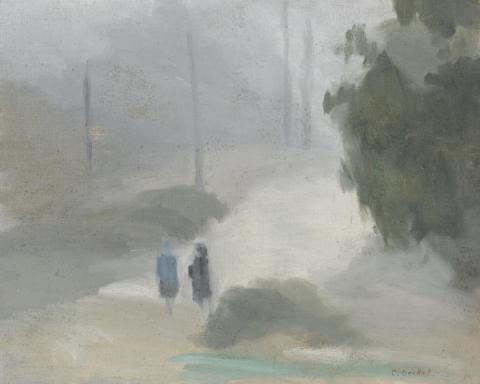RAINY MORNING, c.1930
CLARICE BECKETT
oil on canvas on board
38.0 x 46.5 cm
signed lower right: C. Beckett
signed verso: Clarice Beckett
signed and titled verso: “Rainy Morning” / Clarice Beckett / WAXED
inscribed on paper label verso: RAINY MORNING / C BECKETT
Private collection, Melbourne
Deutscher Fine Art, Melbourne
Wesfarmers Art Collection, Perth, acquired from the above in 1997 (label attached verso)
Possibly Paintings by Miss Clarice Beckett, Athenaeum Hall, Melbourne 5–20 June1923, as 'Rainy Morning, St Kilda'
The appeal of the landscape is a diverse thing, familiarity often breeding desire. The atmosphere generated by a place and its associations attracts - the holiday beach or remembered city bridge - as in Sandringham Beach c1933 (National Gallery of Australia, Canberra), and Princes Bridge 1930 (private collection). There are also times of the day and the seasons, Rainy Morning recollecting both. Clarice Beckett was very much a painter of atmosphere - of warm sunlight on placid waters, foggy days, others misty and wet, or of sunrises, sunsets, and night light reflections. Spring blossoms, summer fields, and stormy winter seas are all part of her landscape vocabulary. She also imbued her paintings with a lyrical poeticism. In Silver Morning (Near Beaumaris) c1931 (Castlemaine Art Gallery and Historical Museum, Victoria), for example, a simple scene of sand, boats and water is transformed into something enchanting, the prosaic made beautiful. This characterises all her work for her choice of subjects is often very commonplace - bathing boxes on Melbourne's bay side beaches, city streets with motorcars, a taxi rank. If you take away the reflections and wetness of Beach Road after the Rain c1927 (National Gallery of Victoria, Melbourne), you are left with telegraph poles! Yet such was her talent that she could make them look quite elegant.
The soft focus of her style suits perfectly the transient moments of nature, lights shining on wet roads, objects mirrored on still waters, rising and falling light. Never has an ordinary transcript of beach looked more entrancing than in Wet Sand, Anglesea (also called 'Sunrise, Anglesea') 1929.1 Verisimilitude is incidental, as also in the painting on offer, as the artist created tone poems embracing different moods and moments. The association with poetry and music is fundamental to her art, Beckett once saying, 'My pictures like music should speak for themselves'.2 In Beckett's art we face the ineffable, where intuition and intellect dwell in wordless harmony. The individuality of her achievement was remarked on by her contemporaries, the art critic for The Bulletin stating that she 'has become the most original painter in Australia'.3 Some of Beckett's especially admired works are of rain and mist. Wet Evening c1927 is in the Castlemaine Art Gallery and Misty Evening, Beaumaris 1930, quite different in season, is in the Art Gallery of Ballarat. In Rainy Morning, the isolation of the two figures within the harmony of greys, touched with cool blues, enriches the contemplative mood of the painting. Paradoxically, her pictures are remarkably objective in the absence, locations aside, of biographical intrusion. Creatively they overflow with the serene spirit of her presence.
1. Private collection, Melbourne
2. Quoted in Hollinrake, R., Clarice Beckett: Politically Incorrect, The Ian Potter Museum of Art, University of Melbourne,1999, p. 19
3.'The Palette', Bulletin, 29 October 1930, p. 33, being a review of Beckett's exhibition at the Athenaeum Gallery, Melbourne, October 1930
DAVID THOMAS
